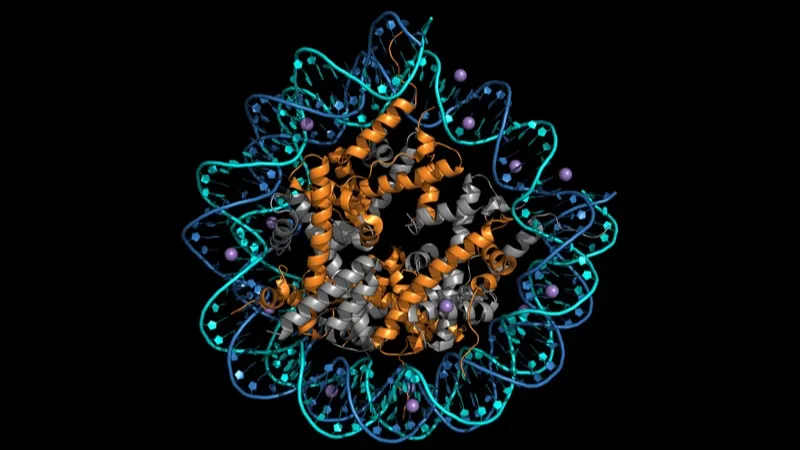Researchers have demonstrated that rapamycin, a drug that has long been believed to slow down aging, changes the way DNA is stored inside cells to support gut health and longevity [1]. This improvement to DNA storage has been observed in both fruit flies and mice in the lab, and the researchers believe that those benefits could translate to humans.
Our DNA is stored inside our cells and is so tightly and efficiently packed that each two-meter-long molecule fits into the tiny cell nucleus. Our cells achieve this by winding the DNA a number of times around the histones, a family of proteins associated with nuclear DNA that helps to compact it into chromatin. Once the DNA is compacted and wrapped, it can then start forming chromosomes.
How tightly wound the DNA is around the histones also decides which genes can be expressed. Interestingly, the number of histones is also known to decline with advancing age in various species. This would, by its nature, lead to less tightly packed DNA and, presumably, more genes being expressed, which is not good news if some of those genes support aging.
Until now it was not clear if these changes in histone numbers might be a point of intervention in slowing aging.
A new target of rapamycin
Rapamycin is best known for its targeting of the TOR pathway, so much so that TOR stands for target of rapamycin. This suppression of TOR is why researchers have long believed it could potentially slow down aging.
TOR is one of the four key metabolic pathways that regulate aging. Studies have shown that turning down the activity of this pathway reliably increases lifespan in yeast, worms, and mice. Rapamycin reduces the activity of TOR, which regulates energy metabolism and nutrient sensing.
It also influences an array of cellular functions, including stress status and protein assembly. Finally, it has been shown to be a potent inducer of autophagy in a wide range of cells, including yeast and mammalian cells. Autophagy is an important recycling system in cells that allows them to break down defective or unwanted proteins and cellular components in order to assemble new ones.
Essentially, TOR is a master regulator of cellular and energy metabolism, and drugs that can reduce its activity may help to slow down human aging.
The link between TOR and histones
Researchers already knew that histone levels decline with age and influence aging. However, it was unclear whether there was a link between the TOR pathway and those histone levels along with whether such a link could be used as a drug target to potentially slow down aging.
To determine this, the researchers administered rapamycin to fruit flies and examined the organs and tissues both before and after. They observed that histone levels increased following rapamycin treatment. However, perhaps the most intriguing thing was that this only happened in gut cells of the flies and not in other tissues.
Next, the team showed that an increased level of histones in gut cells known as enterocytes could reduce the incidence of tumors and their growth. This also improved gut health and led to an increase in lifespan of the animals. The lifespan was not really a surprise given that rapamycin can reliably increase healthy lifespan in many species.
They also repeated this in mice, and similar results were observed following administration of rapamycin.
Abstract
Age-related changes to histone levels are seen in many species. However, it is unclear whether changes to histone expression could be exploited to ameliorate the effects of ageing in multicellular organisms. Here we show that inhibition of mTORC1 by the lifespan-extending drug rapamycin increases expression of histones H3 and H4 post-transcriptionally through eIF3-mediated translation. Elevated expression of H3/H4 in intestinal enterocytes in Drosophila alters chromatin organisation, induces intestinal autophagy through transcriptional regulation, and prevents age-related decline in the intestine. Importantly, it also mediates rapamycin-induced longevity and intestinal health. Histones H3/H4 regulate expression of an autophagy cargo adaptor Bchs (WDFY3 in mammals), increased expression of which in enterocytes mediates increased H3/H4-dependent healthy longevity. In mice, rapamycin treatment increases expression of histone proteins and Wdfy3 transcription, and alters chromatin organisation in the small intestine, suggesting that the mTORC1-histone axis is at least partially conserved in mammals and may offer new targets for anti-ageing interventions.
Conclusion
This study shows for the first time that there is a direct link between the TOR pathway and histone levels. Further, it also shows that this link is a regulator of longevity and health. The link establishes not only the metabolic targets of rapamycin but also that it has an influence on genomic instability and epigenetic alterations, both of which are primary causes of aging.
These results’ replication in mice also suggests the potential that this could translate to humans and that this is a common mechanism. This finding builds upon our knowledge of why we age and how each of these processes interact to determine longevity.
Rapamycin has the potential to slow down human aging and should be a focus of translational research right now. The initial patent on rapamycin expired in 1992, so it is a generic drug and could be manufactured cheaply and at scale, making it a great candidate for the first potential anti-aging drug.
Literature
[1] Lu, Y. X., Regan, J. C., Eßer, J., Drews, L. F., Weinseis, T., Stinn, J., … & Partridge, L. (2021). A TORC1-histone axis regulates chromatin organisation and non-canonical induction of autophagy to ameliorate ageing. Elife, 10, e62233.



